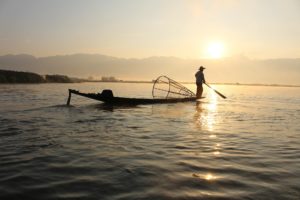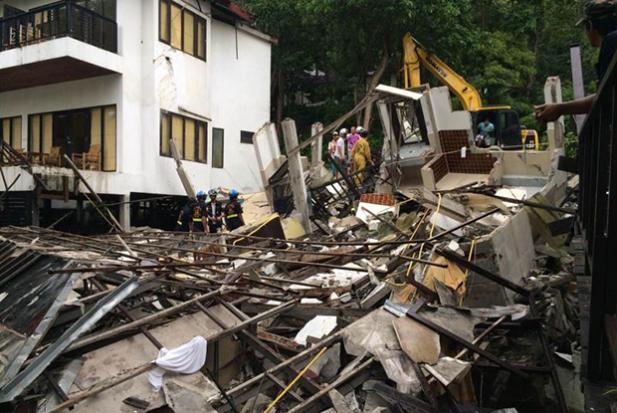 China Opens Rail Line and Trade Route to Indian Ocean Through Myanmar
China Opens Rail Line and Trade Route to Indian Ocean Through Myanmar
China last month inaugurated a new trade route via ship, road and rail running through Myanmar in keeping with Beijing’s dogged building spree across the Southeast Asian country to reach the Indian Ocean and points west.
Analysts say it is one more strand in the ever-expanding web of transportation channels pulling China and Southeast Asia closer under the banner of Beijing’s sprawling Belt and Road Initiative while boosting China’s sway across the region.
Whether the new route actually pays off, they add, may hinge on whether and when new rail lines are laid across Myanmar, a challenge made tougher by the violent turmoil the country has tipped into since its Feb. 1 coup.
Ties that bind
The Chinese Embassy in Myanmar announced the opening of the route after a successful test run with a post to its Facebook page.
The trip started out by ship from Singapore to Yangon, Myanmar’s commercial hub, where it continued by road to the country’s border with China at Chinshwehaw, on the border with China’s Yunnan province. The cargo then finished the last leg of the journey over a new rail line from the border to Chengdu, the capital of China’s central Sichuan province.
The embassy called it a new route for Beijing to the Indian Ocean and “an important breakthrough in strengthening China-Myanmar trade relations.”
Bryan Tse, Myanmar analyst for the Economist Intelligence Unit, told VOA the project, “as with many of similar nature in Southeast Asia, will help strengthen trade ties between China and the region, and thus increase Chinese influence there.”
Li Mingjiang, a China policy expert at Singapore’s S. Rajaratnam School of International Studies, said the new train tracks in China upgrade a trade route that has existed for years and will complement the China-Myanmar Economic Corridor, a cornerstone of Beijing’s BRI.
The corridor already features twin oil and gas pipelines bisecting Myanmar from the Bay of Bengal in the west to its border with China in the east, passing through Mandalay along the way. A deep-water port where the pipelines hit the coast is under construction. China’s plans also envision a high-speed rail line and expressway tracing the same path as the pipes, with an offshoot running south from Mandalay to Yangon, on the Andaman Sea.
Critically for Beijing, the Bay of Bengal and Andaman Sea both open onto the Indian Ocean. That gives China’s oil and gas imports from the Middle East an alternative to passing through the chokepoint of the Malacca Strait near Singapore, a potential liability in the event of a conflict.
Off the rails
With the rail line from the China-Myanmar border to Chengdu now up and running, China says the new trade route through Myanmar via Yangon will shave weeks off the time it takes to move goods between the Indian Ocean and Sichuan.
Li, though, said the overland stretch through Myanmar by road makes for a tight bottleneck and will probably prove impractical for anything but specialty, high-value goods.
“It’s too slow, and also in terms of volume it’s quite limited, and that’s going to be a major constraint,” he said.
According to the analyst, the only real fix is for China to convince Myanmar to start laying new rail lines across Myanmar itself.
“That’s the only way, but for a long time Myanmar has been not very supportive of such ideas. Even if Myanmar eventually agrees to this proposal, it will take time to build,” Li said, a few years at least.
Until then, he added, the volume of goods China can move over the new trade route through Yangon will also do little to address Beijing’s “Malacca dilemma.”
Facing loud opposition from locals along the proposed path of the tracks who fear losing their land for little or no compensation, Myanmar has only reluctantly agreed to China’s requests for feasibility studies.
Tse said concerns over feasibility and cost have added to the delays.
“Many joint projects have thus far suffered the same fate, and there are not many reasons to expect this to change for the better given the significantly poorer geopolitical and macroeconomic policy environment the [Myanmar] junta now finds itself in,” he said.
Already hobbled by the pandemic, Myanmar’s economy has taken another big hit since the military toppled the country’s democratically elected government in February. Fitch Solutions, an international ratings agency, expects Myanmar’s economy to contract at least 20% this year.
Tse said the new trade route as it stands could give the economy a boost, but not enough to “move the needle.”
Trading favors
Khin Khin Kyaw Kyee, who follows China-Myanmar relations at Myanmar’s Institute for Strategy and Policy, a local think tank, expects even less from the new route.
A handful of officials and well-connected companies may well cash in on logistics fees, she said, “but in terms of the ordinary … people and Myanmar as a country, I’m not sure whether we will be getting a lot of benefits.”
What ordinary people need at least as much as infrastructure upgrades, she said, were better bilateral trade policies to help even the playing field with China and to formalize the large volume of informal cross-border trade now exposed to the whims of local officials.
Khin Khin Kyaw Kyee added that the new trade route also has to contend with the uptick in fighting the coup has sparked between the military and armed rebel groups vying for territory on Myanmar’s fringes, some of them near the very stretch of the China-Myanmar border the route crosses.
Since the coup, rights groups say Myanmar’s security forces have killed more than 1,000 civilians and arrested thousands more in their bid to put down all forms of resistance to the junta, from protests to neighborhood militias and a civil disobedience movement. The U.S. and other Western countries have responded with a series of sanctions targeting senior military officials and their vast business interests.
China and Russia, though, both major arms suppliers to Myanmar, have helped shield the junta from more coordinated international pressure at the United Nations.
By embracing the new trade route, Khin Khin Kyaw Kyee said, the junta sees one more opportunity to keep China on its side.
“At this point what they are all thinking is to woo China, to please China, so that they will get more diplomatic protection in the international community,” she said.
Source: https://www.voanews.com/east-asia-pacific/china-opens-rail-line-trade-route-indian-ocean-through-myanmar

